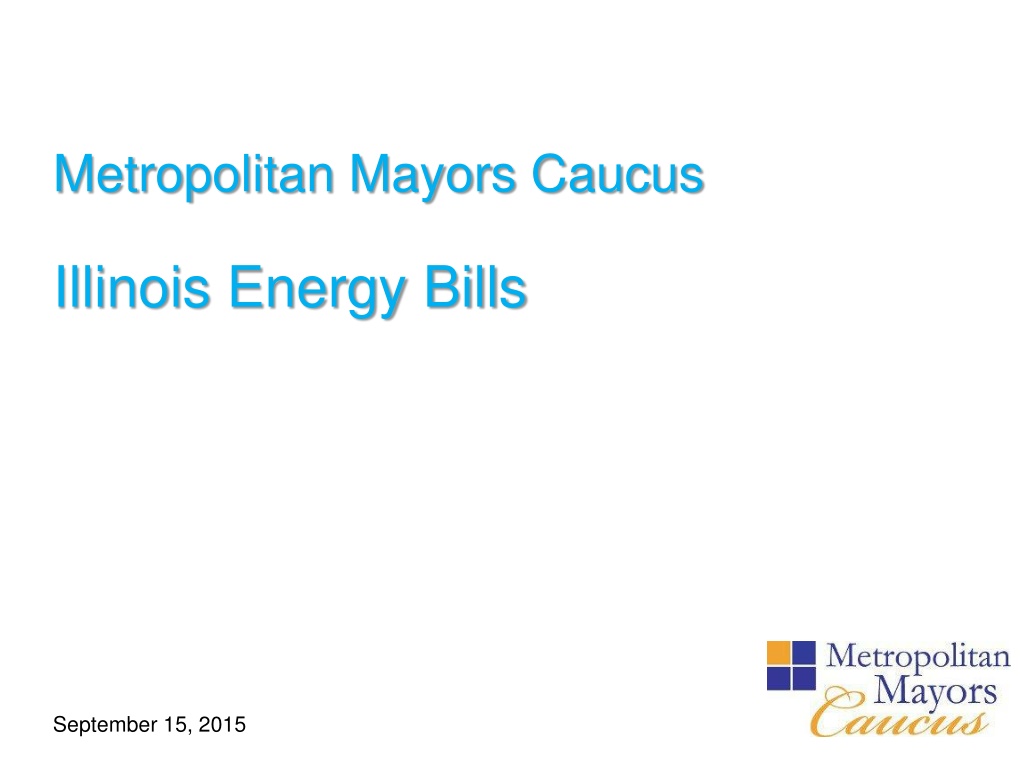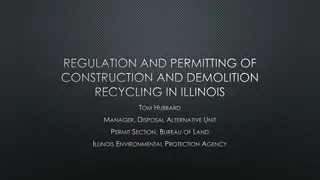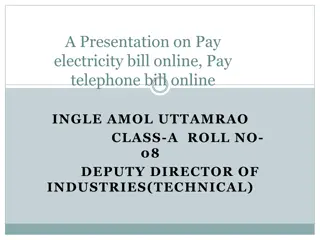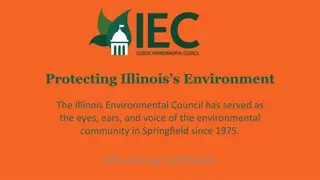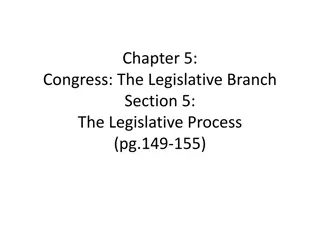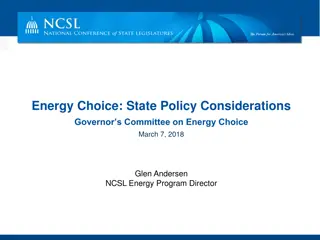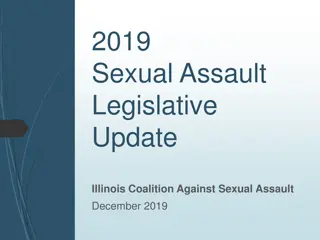Illinois Energy Bills Impact Overview September 15, 2015
Metropolitan Mayors Caucus in Illinois reviewed potential impacts of renewable energy, distributed generation, infrastructure investments, and clean power plan focusing on SB1879/HB3328 ComEd Bill. The bill releases funds for renewable energy investments, outlines solar procurement requirements, mandates microgrid projects, and promotes electric vehicle charging stations. It emphasizes job creation, energy efficiency measures, and community impacts with a focus on local grid strengthening and resiliency.
Download Presentation

Please find below an Image/Link to download the presentation.
The content on the website is provided AS IS for your information and personal use only. It may not be sold, licensed, or shared on other websites without obtaining consent from the author. Download presentation by click this link. If you encounter any issues during the download, it is possible that the publisher has removed the file from their server.
E N D
Presentation Transcript
Metropolitan Mayors Caucus Illinois Energy Bills September 15, 2015
Overview Potential Impacts Reviewed Renewable Energy Distributed Generation Infrastructure Investment Illinois Jobs Energy Efficiency Clean Power Plan Community Impacts Page 2
SB1879/HB3328 ComEd Bill Releases IPA renewable energy funds to invest openly in renewables to fix current RPS 50% of non-distributed generation solar PV procurement must come from brownfield sites 50% of funds available for solar PV procurement must go towards purchasing low-income community solar RECs Renewable Energy Distributed Generation Outlines net metering and meter aggregation requirements Six microgrid projects located in Bronzeville, the Illinois Medical District, an Airport in Winnebago County, Chicago Air Route Traffic Control Center in Aurora, the DuPage County Courthouse and Administration Building in Wheaton, and the Water Pumping and Treatment Facilities in Chicago Heights. Investment capped at $300 million. Installation of up to 5,000 electric vehicle charging stations located in publicly accessible, municipal, or long-term/overnight parking areas, workplace locations, and economically disadvantaged communities. Investment capped at $100 million over 5 years. Infrastructure Investment Required in Bill: 400 full-time equivalent jobs, with 50 per microgrid pilot, 50 through development of EV charging stations, and 50 from voltage optimization projects Illinois Jobs Classifies voltage optimization projects as energy efficiency measures Shifts energy efficiency procurement entirely to utilities Forbids including price suppression effects as a benefit in TRC tests Energy Efficiency Clean Power Plan No specific reference Rate structure changes from a kWh supplied charge to a kW peak demand charge Average customer bill projected to initially decrease and then increase Utilities must contribute $10 million per year for 5 years to the energy low-income and support program Community Impacts Page 3
SB1879/HB3328 ComEd Bill Overview: Takes advantage of smart grid infrastructure and focuses on improving grid security and resiliency through installing microgrids, encouraging distributed generation, and focusing on voltage optimization Key Municipal Impacts Strengthens local grid through six pre-selected pilot microgrid projects Improves grid efficiency through voltage optimization Improves grid operation through energy storage with electric vehicle charging stations Requires the creation of 400 full-time equivalent jobs in Illinois $50,000,000 earmarked to support low-income customers Encourages community solar development, specifically low-income community solar, and solar development on brownfields Projected to have limited impact on average customer bill due to changes in rate design and infrastructure investments Page 4
SB1485/HB2607 Clean Jobs Bill Creates a new RPS structure to fix problems associated with municipal aggregation Increases goal to 35% renewable generation by 2030 Requires a long-term Renewable Resource Procurement Plan to spur investment Creates a declining block program to promote solar industry development Creates a low income solar program Encourages investment in low-income community PV projects and brownfield PV projects through RPS components Protects from government budget sweeps by making renewable funds a delivery surcharge Renewable Energy Restates requirement for open access to grid connection for distributed generation Outlines on-bill credit process for community solar programs RPS requires that 75% of solar procured be from distributed resources Distributed Generation Infrastructure Investment Not grid focused Required in Bill: None Projected: 32,000/year once implemented1 Illinois Jobs Increases cumulative annual reduction goal to 20% by 2025 Low-income energy efficiency carve-out of 12.5% of funds Requires demand response measures to reduce peak demand by 0.1% for all delivery customers Allows Non-Energy Benefits to be include in TRC tests Energy Efficiency Clean Power Creation of a market-based cap-and-auction system to meet compliance requirements Stipulates use of revenues from auction Plan Reinvestment of cap-and-auction revenue to support low income communities, communities where power plants are/have been located, the transition of fossil-fuel plant workers to clean energy jobs, and the development of new renewable and energy efficiency resources 1: Based on a study by the Illinois Science and Technology Institute Community Impacts Page 5
SB1485/HB2607 Clean Jobs Bill Overview: Aims to spur investment and create jobs in renewable resources and energy efficiency by mandating a long-term Renewable Resources Procurement Plan, creating a new Renewable Portfolio Standard with higher requirements, and increasing the Energy Efficiency Resource Standard Key Municipal Impacts Creates more energy efficiency and demand response programs and encourages distributed generation Several mechanisms in place to overcome barriers to investment in distributed generation solar PV and promote industry development Encourages solar development, especially in low-income communities and on brownfield sites, and the development of community solar programs Projected creation of 32,000 clean jobs annually Page 6
SB1585/HB3293 Exelon Bill Renewable generation units cannot sell both low carbon energy credits and renewable energy credits for the same MWh of generation Renewable Energy Distributed Generation Not discussed Infrastructure Investment Not discussed Illinois Jobs Required in Bill: None, but may help prevent nuclear plants from closing Energy Efficiency Not discussed Adoption of a Clean Power Plan compliance plan will replace the Low Carbon Portfolio Standard after 2021 Clean Power Plan Utility recovers costs of procuring low carbon energy credits through an additional cents per kWh charge for all customers Community Impacts Overview: Creates a Low Carbon Portfolio Standard that requires electric utilities to procure low carbon energy credits equal to 70% of their retail sales. A low carbon energy credit and a renewable energy credit cannot be issued for the same MWh of generation. Key Municipal Impact Focus on preserving jobs associated with nuclear generation facilities Page 7
Energy Bills at a Glance ComEd Bill Clean Jobs Bill Exelon Bill Renewable generation and energy efficiency investments Low carbon electric generation through low carbon energy credits Microgrids & distributed generation investments Emphasis Increases investment by creating a new RPS, requiring long-term renewable procurement plans, and encouraging distributed generation Increases investment by allowing renewables to receive either low carbon energy credits or renewable energy credits for generation Increases investment by releasing government funds and encouraging distributed generation Approach to Renewables Increases utility role in energy efficiency procurement and focuses on voltage optimization Approach to Energy Efficiency Increases Energy Efficiency Resource Standard requirements No change to current requirements and processes Mandates the creation of 400 full-time equivalent jobs Projected to create 32,000 full-time equivalent jobs annually Preserves jobs tied to existing nuclear fleet Illinois Jobs Page 8
